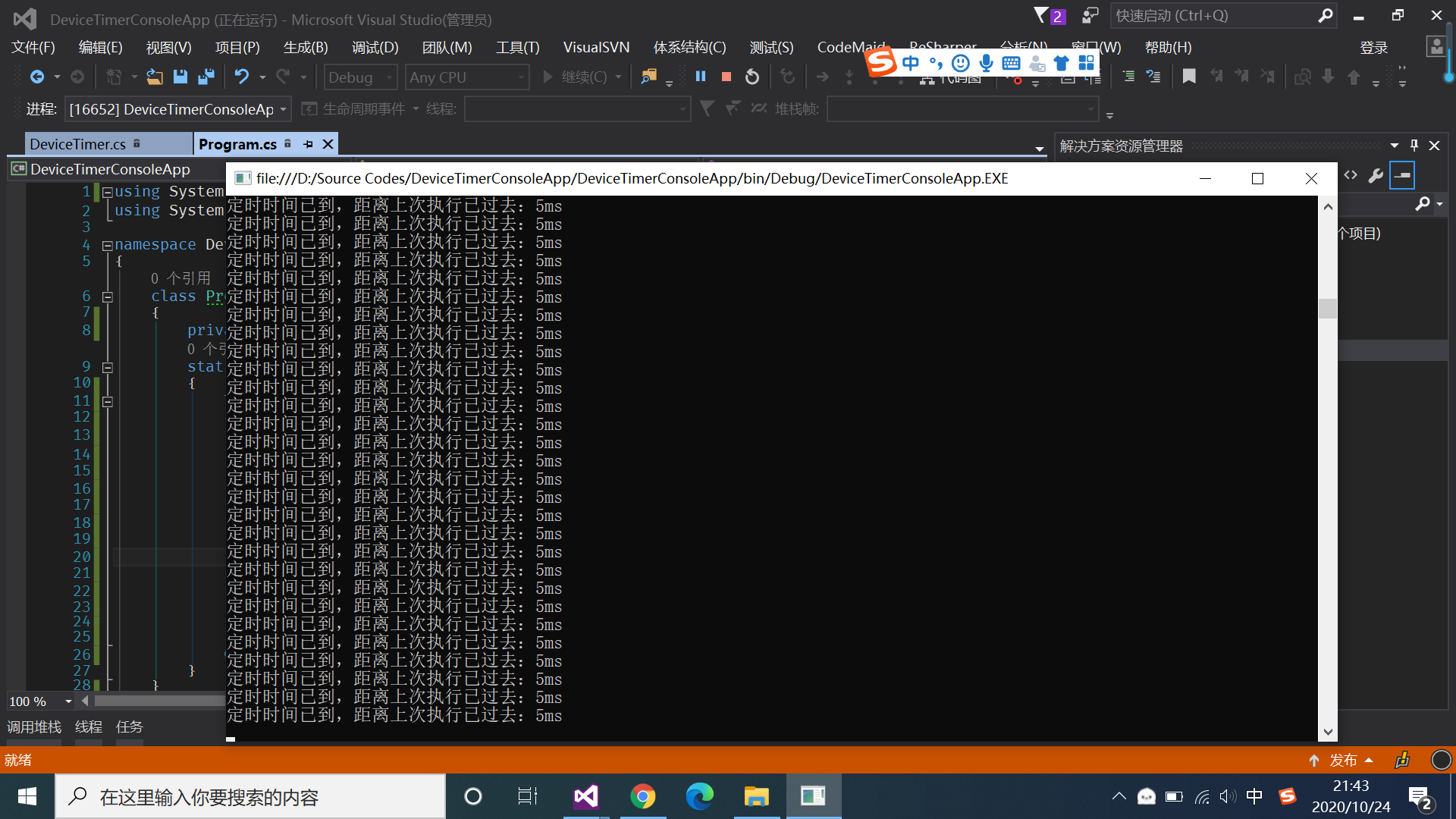C# 创建高精度定时器
背景
我们知道在.NET Framework中存在四种常用的定时器,他们分别是:
1 两个是通用的多线程定时器:
System.Threading.TimerSystem.Timers.Timer
2 两个是专用的单线程定时器
System.Windows.Forms.Timer(Windows Forms 的定时器)System.Windows.Threading.DispatcherTimer(WPF 的定时器)
通常他们的精度只能维持在10-20ms之间,这个和操作系统相关,所以我们在很多场景下面这个是不能够达到我们精度的要求的,如果要实现这一需求我们该怎么办,当然也有很多办法,今天主要介绍一种Stopwatch来实现的方式,网上有很多采用Win32 Dll的API这个当然是可以的,这篇文章的重点不是去讨论这个,关于使用Win32 API的方式可以参考这里。
实现
using System;
using System.Collections.Generic;
using System.Diagnostics;
using System.Linq;
using System.Runtime.InteropServices;
using System.Text;
namespace Pangea.Common.Utility
{
/// <summary>
/// .Net Stopwatch对高精度定时器作了很好的包装
/// DeviceTimer内部采用Stopwatch类实现高精度定时操作
/// </summary>
public sealed class DeviceTimer
{
#if USE_CPU_COUNTING
//引入高性能计数器API,通过对CPU计数完成计时
[DllImport("Kernel32.dll")]
private static extern bool QueryPerformanceCounter(out long lpPerformanceCount);
//获取当前CPU的工作频率
[DllImport("Kernel32.dll")]
private static extern bool QueryPerformanceFrequency(out long lpFrequency);
#else
/// <summary>
/// 获取TickCount64计数
/// </summary>
/// <returns></returns>
//[DllImport("kernel32.dll")]
//public static extern long GetTickCount64();
#endif
private enum DeviceTimerState
{
TM_ST_IDLE = 0,
TM_ST_BUSY = 1,
TM_ST_TIMEOUT = 2,
}
/// <summary>
/// Stopwatch object
/// </summary>
Stopwatch _stopWatch = new Stopwatch();
/// <summary>
/// 定时器内部状态
/// </summary>
DeviceTimerState _state;
/// <summary>
/// 定时器开始计时时刻的相对时间点
/// </summary>
long _startTime;
/// <summary>
/// 定时器超时时刻的相对时间点
/// </summary>
long _timeOut;
#if USE_CPU_COUNTING
/// <summary>
/// CPU运行的时钟频率
/// </summary>
double _freq;
#endif
/// <summary>
/// 定时时间(单位:ms)
/// </summary>
double _duration;
/// <summary>
/// class constructure
/// </summary>
public DeviceTimer()
{
#if USE_CPU_COUNTING
long freq;
if (QueryPerformanceFrequency(out freq) == false)
throw new Exception("本计算机不支持高性能计数器");
//得到每1ms的CPU计时TickCount数目
_freq = (double)freq / 1000.0;
QueryPerformanceCounter(out _startTime);
#else
_stopWatch.Start();
_startTime = 0;
#endif
SetState(DeviceTimerState.TM_ST_IDLE);
_timeOut = _startTime;
_duration = 0;
}
/// <summary>
/// 内部调用:设置定时器当前状态
/// </summary>
/// <param name="state"></param>
private void SetState(DeviceTimerState state)
{
_state = state;
}
/// <summary>
/// 内部调用:返回定时器当前状态
/// </summary>
/// <returns></returns>
private DeviceTimerState GetState()
{
return _state;
}
/// <summary>
/// 定时器开始计时到现在已流逝的时间(单位:毫秒)
/// </summary>
/// <returns></returns>
public double GetElapseTime()
{
long curCount;
#if USE_CPU_COUNTING
QueryPerformanceCounter(out curCount);
return (double)(curCount - _startTime) / (double)_freq;
#else
curCount = _stopWatch.ElapsedMilliseconds;
return curCount - _startTime;
#endif
}
/// <summary>
/// 获取定时总时间
/// </summary>
/// <returns></returns>
public double GetTotalTime()
{
return _duration;
}
/// <summary>
/// 停止计时器计时
/// </summary>
public void Stop()
{
SetState(DeviceTimerState.TM_ST_IDLE);
#if USE_CPU_COUNTING
QueryPerformanceCounter(out _startTime);
#else
_startTime = _stopWatch.ElapsedMilliseconds;
#endif
_timeOut = _startTime;
_duration = 0;
}
/// <summary>
/// 启动定时器
/// </summary>
/// <param name="delay_ms">定时时间(单位:毫秒)</param>
public void Start(double delay_ms)
{
#if USE_CPU_COUNTING
QueryPerformanceCounter(out _startTime);
_timeOut = Convert.ToInt64(_startTime + delay_ms * _freq);
#else
_startTime = _stopWatch.ElapsedMilliseconds;
_timeOut = Convert.ToInt64(_startTime + delay_ms);
#endif
SetState(DeviceTimerState.TM_ST_BUSY);
_duration = delay_ms;
}
/// <summary>
/// 重新开始定时器
/// 开始的计时时间以上一次Start的时间为准
/// </summary>
/// <param name="delay_ms">定时时间(单位:毫秒)</param>
public void Restart(double delay_ms)
{
#if USE_CPU_COUNTING
_timeOut = Convert.ToInt64(_startTime + delay_ms * _freq);
#else
_timeOut = Convert.ToInt64(_startTime + delay_ms);
#endif
SetState(DeviceTimerState.TM_ST_BUSY);
_duration = delay_ms;
}
/// <summary>
/// 返回定时器是否超时
/// </summary>
/// <returns></returns>
public bool IsTimeout()
{
if (_state == DeviceTimerState.TM_ST_IDLE)
{
//System.Diagnostics.Debug.WriteLine("Warning: Misuage of the device timer. You must start it first before you can use it.");
//System.Diagnostics.Debug.Assert(false, "Warning: Misuage of the device timer. You must start it first before you can use it.");
}
long curCount;
#if USE_CPU_COUNTING
QueryPerformanceCounter(out curCount);
#else
curCount = _stopWatch.ElapsedMilliseconds;
#endif
if (_state == DeviceTimerState.TM_ST_BUSY && (curCount >= _timeOut))
{
SetState(DeviceTimerState.TM_ST_TIMEOUT);
return true;
}
else if (_state == DeviceTimerState.TM_ST_TIMEOUT)
{
return true;
}
return false;
}
/// <summary>
/// 定时器是否在工作中
/// </summary>
/// <returns></returns>
public bool IsIdle()
{
return (_state == DeviceTimerState.TM_ST_IDLE);
}
}
}
这个里面我们在DeviceTimer中定义了一个私有的_stopWatch 对象并且在构造函数中就启动了这个Stopwatch,所以我们在使用的时候是通过先创建一个DeveiceTimer的对象然后我们再调用内部的Start方法,当然在调用这个方法的时候我们需要传入一个定时时间,然后不断检测IsTimeout方法看是否到达定时时间,从而达到类似于定时时间到的效果,另外GetElapseTime()方法能够获取从调用Start方法开始到现在的时间,另外我们还在其中定义了几个枚举值用来表示当前DeviceTimer的状态用于做一些状态的校验,具体数值如下。
private enum DeviceTimerState
{
TM_ST_IDLE = 0,
TM_ST_BUSY = 1,
TM_ST_TIMEOUT = 2,
}
这里还有最后一个问题就是循环调用的问题,这个其实也是非常简单就在一个While循环中不断进行调用,当然下面的代码可以有很多内容供我们去发挥的,这个可以根据自己的需要进行修改。
using System;
using System.Threading.Tasks;
namespace DeviceTimerConsoleApp
{
class Program
{
private static bool flag = true;
static void Main(string[] args)
{
Task.Factory.StartNew(() =>
{
var deviceTimer = new DeviceTimer();
deviceTimer.Start(5);
while (flag)
{
if (deviceTimer.IsTimeout())
{
Console.WriteLine($"定时时间已到,距离开始执行已过去:{deviceTimer.GetElapseTime()}ms");
deviceTimer.Start(5);
}
}
});
Console.ReadKey();
}
}
}
我们来看看定时器的效果




